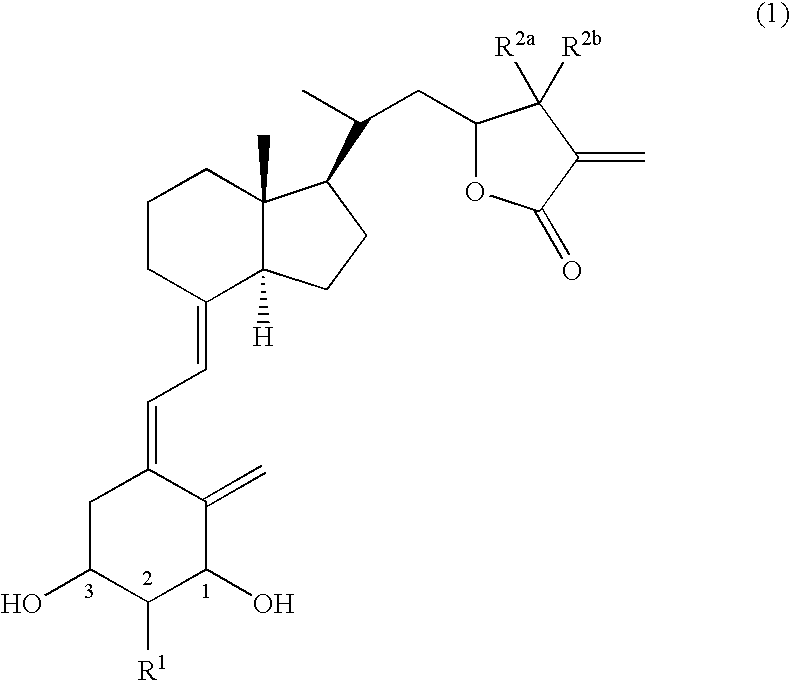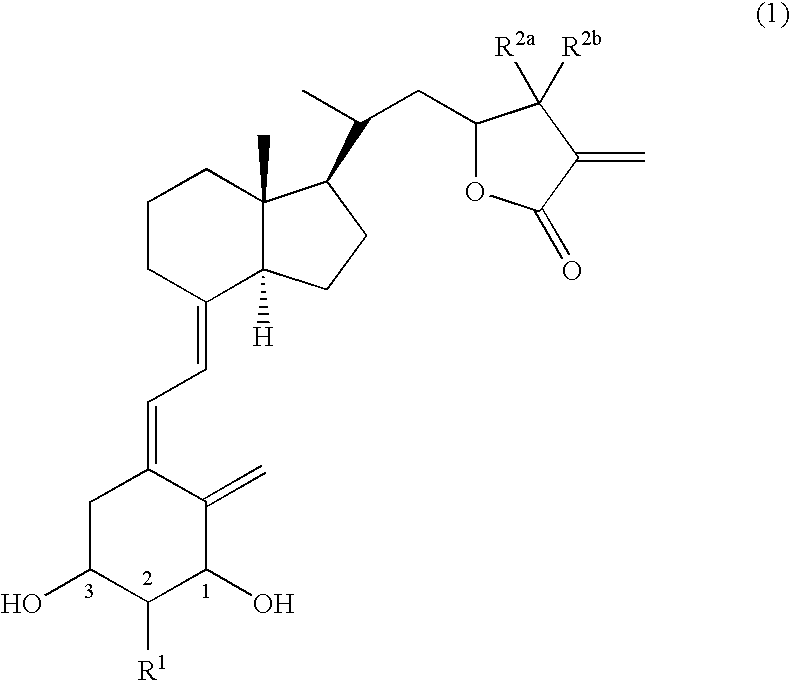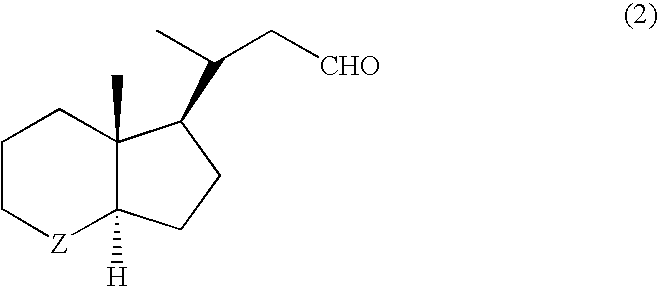Vitamin D3 lactone derivatives
a technology of lactone derivatives and vitamin d, which is applied in the field of 1hydroxyvitamin d3 lactone derivatives, can solve the problems of poor compliance, formulations that cannot completely core the disease, and cannot exert a sufficient inhibitory action on bone resorption
- Summary
- Abstract
- Description
- Claims
- Application Information
AI Technical Summary
Benefits of technology
Problems solved by technology
Method used
Image
Examples
reference example 1
Synthesis of ethyl 2-bromomethyl-2-butenoate (Compound (3a) (R2d / R2e=Me / Hydrogen atom, R7=Et)
[0104]
[0105]The above reaction was carried out according to the literature (Helv. Chem. Acta, Vol. 67, 413-415, 1984).
[0106](1) A reaction solution prepared by mixing 1 g (9.99 mmol) of ethyl acrylate, approximately 0.6 ml of acetaldehyde and 168 mg (1.50 mmol) of DABCO (1,4-diazabicyclo[2.2.2]octane) was stirred at room temperature for 9 days. The reaction solution was extracted with diethyl ether and the organic layer was washed with water. The organic layer was dried with anhydrous magnesium sulfate and concentrated to obtain 1.7 g of allyl alcohol. Yield: 100%.
[0107](2) A reaction solution prepared by adding dropwise 431 μl (5.9 mmol) of dimethylsulfide to a dichloromethane (4 ml) suspension solution of 950 mg (5.3 mmol) of NBS (N-bromosuccinimide) at 0° C. was stirred at 0° C. for 10 minutes. To the reaction solution was added dropwise a dichloromethane solution (6 ml) of 700 mg (4.86 m...
reference example 2
Synthesis of ethyl 2-bromomethyl-2-pentenoate (Compound (3a) (R2d / R2e=Et / Hydrogen atom, R7=Et))
[0109]
[0110]As in Reference Example 1, the reaction was carried out by replacing acetaldehyde with propionaldehyde. Yield: 42% (based on propionaldehyde).
[0111]1H-NMR (CDCl3) δ: 1.13 (t, J=7.6 Hz, 3 H), 1.33 (t, J=7.1 Hz, 3 H), 2.32 (dt, J=7.6, 15.2 Hz, 2 H), 4.23 (s, 2 H), 4.26 (q, J=7.1 Hz, 2 H), 6.96 (t, J=7.6 Hz, 1 H).
reference example 3
Synthesis of ethyl 2-bromomethyl-2-hexenoate (Compound (3a) (R2d / R2e=Pr / Hydrogen atom, R7=Et))
[0112]
[0113]As in Reference Example 1, the reaction was carried out by replacing acetaldehyde with butylaldehyde. Yield: 29% (based on butylaldehyde).
[0114]1H-NMR (CDCl3) δ: 0.99 (t, J=7.4 Hz, 3 H), 1.33 (t, J=7.1 Hz, 3 H), 1.49-1.62 (m, 2 H), 2.28 (q, J=7.4 Hz, 2 H), 4.24 (s, 2 H), 4.26 (q, J=7.1 Hz, 2 H), 6.97 (t, J=7.6 Hz, 1 H).
PUM
| Property | Measurement | Unit |
|---|---|---|
| temperature | aaaaa | aaaaa |
| boiling point | aaaaa | aaaaa |
| boiling point | aaaaa | aaaaa |
Abstract
Description
Claims
Application Information
 Login to View More
Login to View More - R&D
- Intellectual Property
- Life Sciences
- Materials
- Tech Scout
- Unparalleled Data Quality
- Higher Quality Content
- 60% Fewer Hallucinations
Browse by: Latest US Patents, China's latest patents, Technical Efficacy Thesaurus, Application Domain, Technology Topic, Popular Technical Reports.
© 2025 PatSnap. All rights reserved.Legal|Privacy policy|Modern Slavery Act Transparency Statement|Sitemap|About US| Contact US: help@patsnap.com



